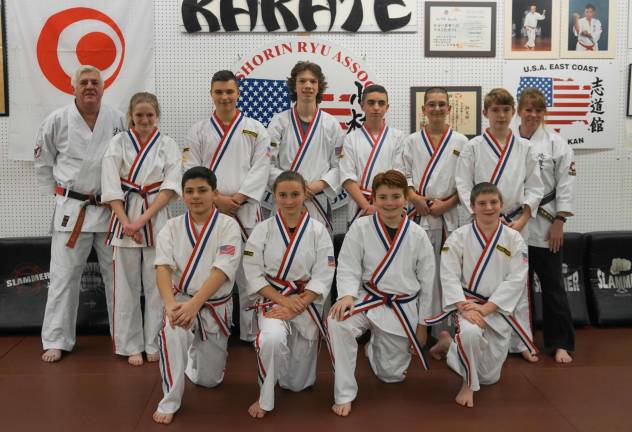Vernon Valley Karate school graduates 10 new leaders

VERNON — The Elite Karate Leadership Squad of ten students graduated, Dec. 5, in the Vernon Valley Karate Academy (VVKA). Sensei and teacher Thomas Shull and Sensei Monica Rolando conducted the eight week fall course in order to develop and prepare potential instructors in VVKA.
Shull said, unlike other Karate schools, VVKA is a school which primarily teaches Tai sabaki — the technique of receiving punches and kicks through shifting the body, or stepping back, and allowing an opponent’s attacks to be avoided. It is a whole different philosophy of martial arts, Shull explained, which works for all sizes of people – big, small, weak or strong. He continued, the technique, taught to them by Sensei Seikichi Iha, is not taught in other schools because it is complicated, difficult to learn, and could be dangerous, if not done properly. “So we practice it over and over,” he said, “but the difference is, it works.”
During the graduation ceremony, the ten students demonstrated the Tai sabaki kicking drill, for parents and loved ones, by receiving the kicks from “opponents.”
They also demonstrated self-defense techniques by evading a double wrist grab and protecting themselves from punches or chokes from the rear. With each attack, the students threw their opponent to the ground – with a thump – thus, taking away the attacker’s ability to hurt.
After each demonstration, the pairs of students bowed to each other — rei in Japanese — and shook hands, showing they were learning from and respecting each other.
The Elite Squad promotion ranks are similar, Shull explained, to the military: Private First Class, Corporal, Sergeant, Sergeant First Class, and Captain. Along with the other promotions, Elite Squad member Connor Shillcock was promoted to Captain, Assistant Instructor, and also started training to become an instructor last week with VVKA.
At the end of the graduation ceremony, the Elite Squad recited the “Student Creed,” “We are future Black Belts; we are dedicated; we are motivated; and we are on a quest to be our best.”
Earlier in the evening, Shull reviewed the four different parts of each Elite Squad session: the history of Karate, terminology in Japanese, past instructors, and respect; Kihon practice — the basics in Karate techniques: blocks, punches, kicks, turns, movements, while demonstrating the correct spirit and attitude — and Kata — practicing organized forms of karate techniques; Leadership — where the squad learns how to aid, teach, and then practice teaching different age group classes; and Kumite – working with another person in basic self-defense techniques, using the techniques learned from the Kihon and Kata.
The students demonstrated Kihon by stepping forward with a lunge punch — punching with the hand which is over the lead foot — and a reverse punch — punching with the other hand. Shull explained, the lunge punch has distance, and the reverse gives more power, “so they practice both.”
They also demonstrated the “Pinan Shodan Kata,” which Shull said, means peaceful within oneself – the first of the five peace katas developed in Okinawa.
Shull said, the art of self-defense is “a science” - every move the students completed had a purpose which they were learning – bunkai – analysis of the kata.